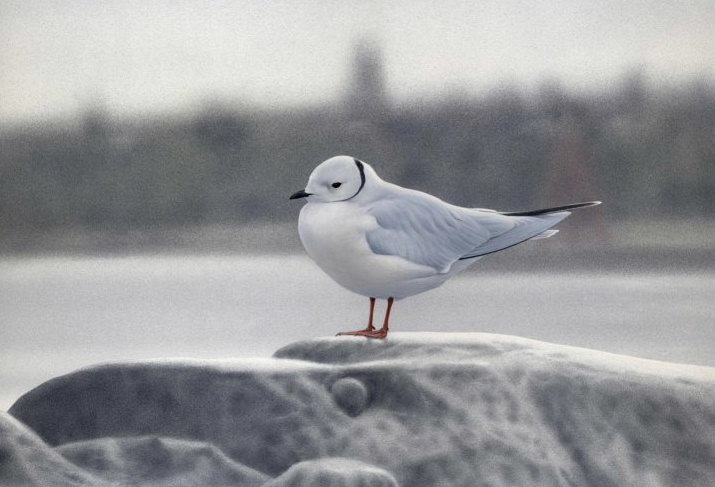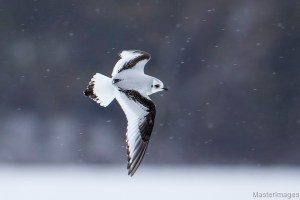
© Ian Lewington.Ross's Gull
On a recent Tuesday afternoon, some carpenters working at Jack Delehanty's home in Tupper Lake put out on the ice some entrails and egg skeins from walleyes they had caught. The next day Jack noticed an unfamiliar bird picking at the walleye eggs. Jack consulted with his sister, Alex, and their mother, Charlcie Delehanty, a longtime birder, and they were also puzzled. Alex then sent me pictures and video they had taken to see if I could identify the bird. That night, I realized it was a first-year Ross's gull,
an incredibly rare vagrant from the Arctic.Thanks to the internet, my news of the Ross's gull reached the birding community within hours, and hundreds of birders from all over the country and Canada soon flocked to Tupper Lake (and Jack's home!) to see the bird, which has been hanging out much of the time near the Tupper Lake boat launch and the causeway near the bridge over the Raquette River. This bird has provided a small but significant economic boost to the Tupper Lake community as hundreds of visiting birders have bought food and gas and occasionally spent the night. A similar appearance of this species in Newburyport, Massachusetts attracted thousands of birders from around the country.

Ross’s gull
), and in the past year there were
only two eBird reports of Ross's gull anywhere in the world. (The eBird website is the primary way that birders around the world record their observations.)
The other report was an adult bird in California two weeks ago (the state's second ever reported Ross's gull) that did not end well as the bird was killed by a pair of peregrine falcons.
Ross's gull landing at Tupper Lake in Jan 2017 by Larry MasterThe worldwide population of Ross's gulls may be under 10,000 breeding pairs (IUCN Red List), with fewer than 10 pairs known in Canada (where it is considered "threatened"), a handful of pairs in Greenland and Svalbard, and as many as 10,000 pairs in Russia. Trends are largely unknown, but climate change in the high Arctic surely does not bode well for this species. Oil and gas development, disturbance at nest sites, egg collecting, and hunting of the birds on migration in northern Alaska are also potential threats.
NatureServe considers the species to be "vulnerable".
Two other unusual bird species have been seen in Tupper Lake in recent years. Just last summer, a pair of sandhill cranes nested in the marsh beside Simon Pond and raised two offspring, the first recorded nesting of this spectacular species in the Adirondacks. Four years ago, a great gray owl, a magnificent creature of the northern forest, was spotted alongside the highway just outside of town, delighting many people over the two to three days it remained. Going back much further in time, Charlcie Delehanty recorded New York State's first western grebe on the waters of Tupper Lake in the summer of 1978. These sightings led many birders to visit Tupper Lake to see these unusual and beautiful birds.
Images of the Tupper Lake Ross's gull may be seen here and videos may be seen
here.
Comment: See also: Rare high Arctic gull turns up in Half Moon Bay, California